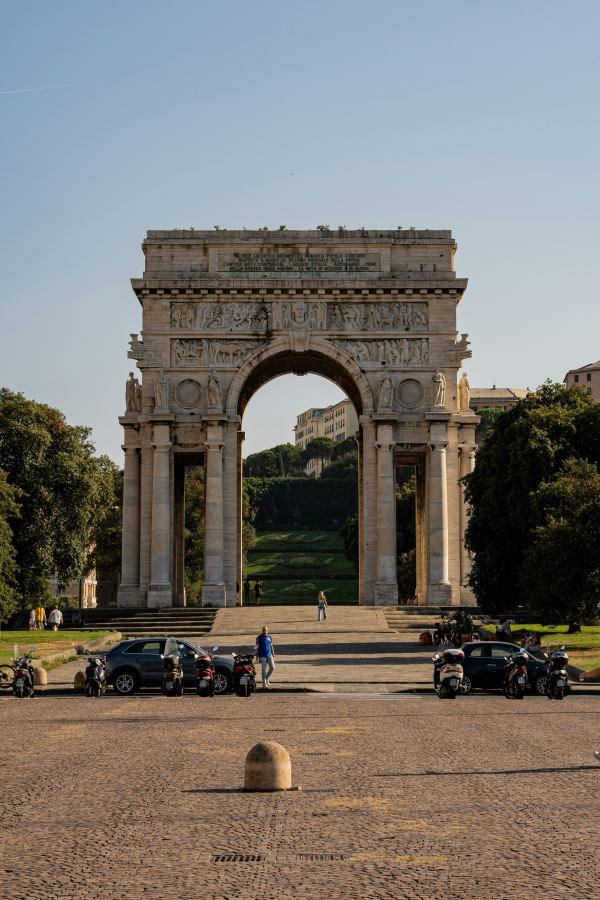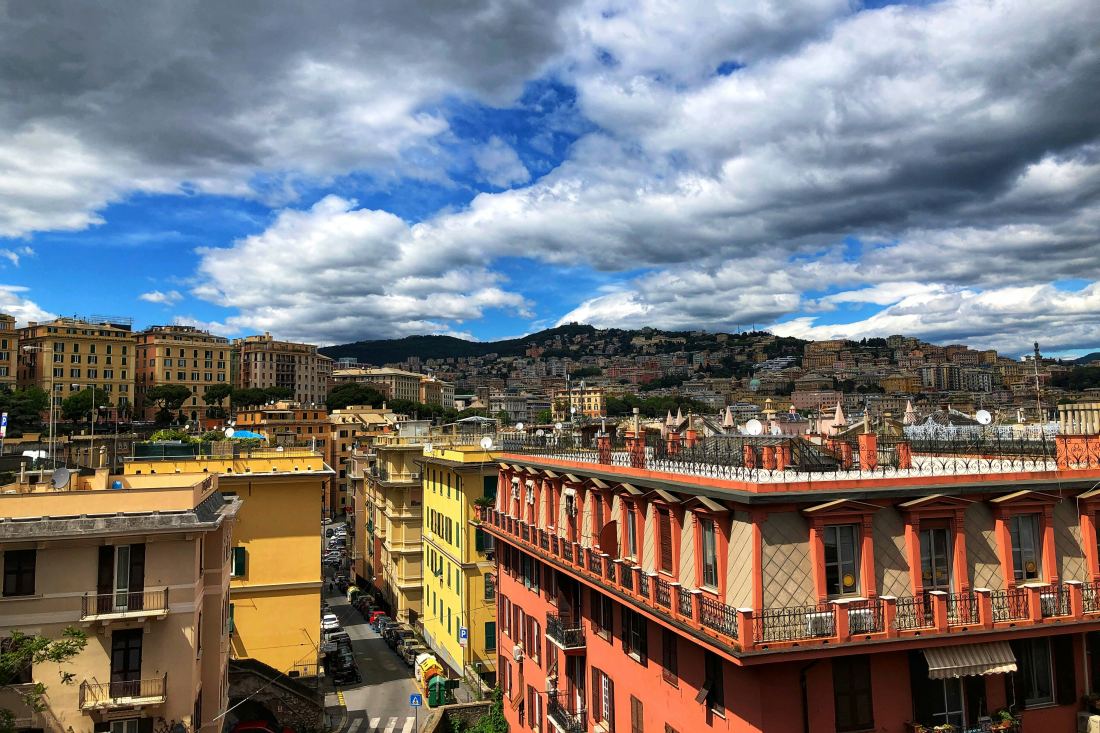Genoa is still one of the Mediterranean’s major port cities, and due to its history, it harbors numerous wonderful attractions.
For more than seven centuries, from the 11th century until 1797, it was the capital of one of the most powerful maritime republics. It is Italy’s largest port and the second-largest port in the Mediterranean (after Marseille).
Table of Contents
Genoa attractions
Old Port (Porto Vecchio)
One of Genoa’s most significant tourist and cultural centers.
Once one of the Mediterranean’s most important commercial ports, it lost its economic significance by the end of the 20th century. However, the port was reborn for the 1992 World Exposition (Colombo ’92) when it was completely transformed under the leadership of Renzo Piano, the world-famous Genoese architect.
One of the site’s unique features is the Biosfera. This futuristic glass sphere contains a mini rainforest with rare plants and birds. Another distinctive structure is the Bigo, a crane-shaped observation tower that offers fantastic panoramic views of the port and city.

Piazza de Ferrari
This busy and bustling square is where modern and ancient Genoa meet.
The Carlo Felice Theater, or Opera House, rises at its northern end. The Doge’s Palace (Palazzo Ducale) stands in its western corner, while the Stock Exchange Palace (Palazzo della Borsa Valori) is located in the southeastern part.
The city center is full of vibrant life. The elegant shopping street, Via XX September, begins from the square, where you can walk, shop, and browse under the ornate arcade of palaces built from the late 19th century and streets connected by stone bridges.

Cathedral of San Lorenzo (Cattedrale di San Lorenzo)
Genoa’s most important religious building is located in the historic city center.
Construction began in the 12th century in Romanesque style, later expanded with Gothic and Renaissance elements. The cathedral’s facade features black and white stripes, a trademark of Ligurian architecture. Of the two towers, the right one remained unfinished.
The church was built in honor of Saint Lawrence and houses relics related to the saint. Part of John the Baptist’s remains are kept in the Chapel of Saint John. The chapel, with its special marble covering and artworks, is one of the most beautiful parts of the cathedral.

Galleria Giuseppe Mazzini
Similar to Milan’s covered walkway, it was named after Giuseppe Mazzini, a key figure in Italian unification.
The gallery is located near the Teatro Carlo Felice opera house and Piazza De Ferrari. Architecturally, it follows the style of 19th-century European covered galleries.
Today, Galleria Giuseppe Mazzini houses exclusive shops, bookstores, and historic cafes. It also serves as a venue for cultural events, book launches, and exhibitions.
Victory Arch (Arco della Vittoria)
The monument standing in Piazza della Vittoria was erected in honor of Genoese soldiers who fell in World War I.
The arch was inaugurated in 1931 in the presence of Benito Mussolini. It was designed by Marcello Piacentini, one of the most significant Italian architects of the fascist era. It combines classical and neoclassical elements, decorated with grand columns and reliefs.

Le Strade Nuove
The „New Streets” refers to a district developed in the 16th and 17th centuries, famous for its palaces built during the golden age.
The district is made special by the Palazzi dei Rolli palaces. These buildings were residences of noble families in the 16th century and operated in a unique system: they were buildings designated for official hospitality by the Republic of Genoa, where rulers and diplomats could stay.
Its most famous street is Via Garibaldi, built in the 16th century, containing the most impressive palaces. The Palazzo Doria Tursi is now the city hall and houses Paganini’s famous violin.
D’Albertis Castle
The building is located at one of Genoa’s most scenic locations, on Monte Galletto hill.
Its builder, Captain Enrico Alberto d’Albertis, was a naval officer, explorer, and amateur archaeologist. After traveling the world for many years, he decided in 1886 to build a castle that would serve both as his home and as a showcase for treasures collected during his travels.
The castle was built in Neo-Gothic style and enriched with elements reminiscent of medieval castles, such as bastions and embrasures. After d’Albertis’s death, he left the castle to the city, which turned it into a museum in 1972. The building now houses the Museum of World Cultures of Genoa and provides insight into the adventurous life of the famous sailor and traveler.
Christopher Columbus’s birthplace
The famous explorer’s birthplace is an important historical site.
According to legend, Christopher Columbus was born in Genoa in 1451 and spent his childhood in this house. The original house was destroyed during the French attack in 1684; the current building is a reconstruction. It was completed in the 18th century, attempting to restore its original appearance based on period documents.
The house is small, consisting of two floors, so many say it’s enough to look at it from the outside. Its exhibitions display maps, documents, and objects related to Columbus’s life.
Porta Soprana
One of Genoa’s most famous medieval city gates dates from the 12th century.
The gate was part of the city’s former defensive wall system and still towers impressively over the old town today. It played a key role in Genoa’s defense for many centuries until most of the walls were demolished in the 19th century due to newer urban developments.
The two tall cylindrical towers feature a Romanesque arch. The carved reliefs and coats of arms show the power and history of the Genoese Republic.
Royal Palace (Palazzo Reale)
One of Genoa’s most impressive baroque buildings.
Built in the 1600s, the palace recalls the former splendor of the Genoese aristocracy and the House of Savoy with its luxurious halls, rich art collections, and elegant gardens. The palace has a rich art collection featuring works by world-famous painters including Van Dyck, Tintoretto, Guercino, and Luca Giordano.
We can walk through magnificent state rooms and royal apartments. The Hall of Mirrors, decorated with gilded stucco and glittering mirrors, evokes the style of the Palace of Versailles. Another magnificent part is the Ballroom, featuring elegant frescoes and chandeliers.
All information can be found here!
Villa del Principe / Palazzo di Andrea Doria
This villa near the port was the city’s most luxurious palace.
The palace was built between 1529 and 1533 by Admiral Andrea Doria, one of the most influential figures of the 16th-century Genoese Republic. Doria designed the villa not just as a home but as a princely court worthy of the greatest rulers of the time. The palace remained in the possession of the Doria family for centuries and was one of the most significant historical residences in Italy.
The building is a masterpiece of Italian Renaissance palace architecture, with contributions from the most renowned artists of the time. In the interior rooms, Perin del Vaga, one of Raphael’s students, created beautiful frescoes depicting mythological and historical scenes. Its most impressive room is the Sala dei Giganti, which stands out with its enormous frescoes and grandiose dimensions.
The palace functions as a museum where visitors can admire the wealth of the Doria family, Renaissance art, and the beautiful garden.
All information can be found here!
Aquarium (Acquario di Genova)
One of Italy’s and Europe’s largest and most spectacular marine life facilities is located at the port.
More than 70 tanks house approximately 12,000 animals and 600 species, including fish, marine mammals, reptiles, and amphibians. The dolphin pool is one of the most popular attractions, while various species of sharks and rays swim in the giant shark tank.
All information can be found here!

Museum of the Risorgimento
One of Genoa’s most important historical museums showcases the events and key figures of Italian unification (Risorgimento).
The institution is located in the birthplace of Giuseppe Mazzini, who was one of the most important ideological leaders of Italian unity. The museum displays Mazzini’s original writings, which laid the ideological foundations for Italian unification.
The collection includes military equipment from the Risorgimento era, including uniforms of Garibaldi’s Red Shirts, as well as flags and symbols used during the Italian wars of independence. Notable are the paintings, graphics, period photographs, and newspaper articles commemorating famous figures and battles of the Risorgimento.
All information can be found here!
Maritime Museum (Galata Museo del Mare)
The largest maritime museum in Genoa and the entire Mediterranean region is located in the Galata palace.
The exhibition shows how Genoa became one of the strongest maritime powers of the Middle Ages. A notable part features ship models, maps, and documents from the time of Christopher Columbus.
A unique feature of the museum is a real, full-size Italian submarine that can be visited in the port. Visitors can explore the entire interior and learn about the life of submariners. Additionally, a life-size replica of a 16th-century Genoese galley is on display.
All information can be found here!

